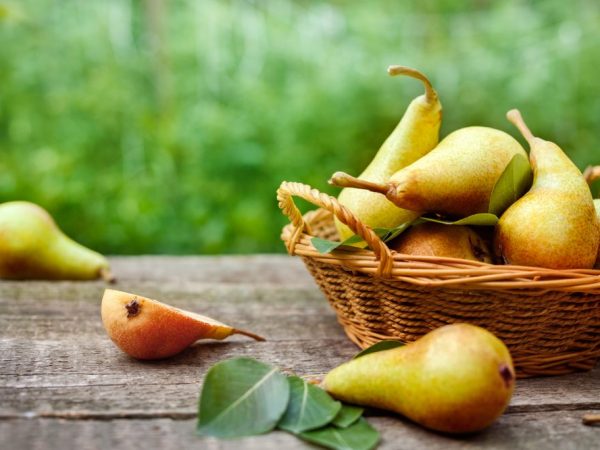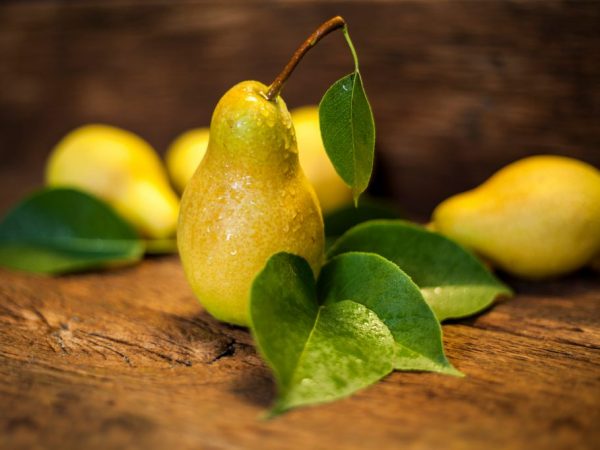Description of the Parisian pear variety
Pear Parisian is unpretentious in care. The Parisian woman quickly takes root on fertile soils, which warm up well in early spring.

Description of the Parisian pear variety
Characteristics of the variety
The Parisian pear belongs to the vigorous varieties. A wide-pyramidal crown is formed on it.
The pear belongs to the thermophilic species - the origin of the variety determines the conditions for its rapid growth.
A pear can hardly withstand a harsh winter: freezing affects the quality of the crop. The tree is pollinated by neighboring varieties, so it is planted near other garden crops. The variety has early flowering: after planting, 3-4 years later, the tree blooms and bears fruit. For another 2-3 years, the trees grow rapidly. The trunk reaches its maximum height in the first 2 years of active growth.
The average yield of one healthy tree is 100 kg. For planting varieties, soils that are special in composition and quality are needed. Winter hardiness of the tree is average: trees can withstand short frosts.
Description of the tree
The Parisian tree grows rapidly. Branches extend from the main trunk (they are located at right angles). The ends of the branches are directed upwards. The shoots have an average thickness. The color of the shoots is dark yellow. The older the tree, the darker the main trunk and older shoots. The main part of the fruit is formed on the geniculate branches.
On the shoots of the tree, yellow lentils are noticeable. The leaves of the Parisienne are rounded, slightly elongated. There are 2 types of foliage on the tree: old leaves are large, and young ones are round and much smaller in size. The foliage surface is smooth with a shiny film. Cuttings are of medium length and thickness. The bark is dark gray with scaly particles.
Description of fruits
- the average weight of one fruit is 150-190 g;
- elongated shape;
- uniform honey-yellow color.
The peduncle is shortened, slightly curved and moderately thick. The peel of the pear is weakly fragrant and thick - thanks to this shape, the fruits do not crack or spread. The pulp is firm and moderately juicy. Inside the pulp there are veins scattered throughout the fruit. The pulp is tender, juicy and sweet. As it ripens, the skin brightens and becomes covered with small specks.
Growing pears
Seedling preparation
The Parisian pear variety is planted in the fall. Two-year-old seedlings take root best of all. The average height of such a seedling is 1.2 m, and the thickness is not more than 1 cm. A material with 3-4 well-developed roots is suitable for planting.

Good results with healthy seedlings
The length of the root system - 18-20 cm - is suitable for planting in any region: it is best to choose land plots with loamy soil. The seedlings should not have dry or damaged parts, and before planting, the pear (planting material) is soaked in purified water.
Planting a seedling
Prepare the soil before planting. Fertilizer and mineral complexes are introduced (they fertilize the planting pit, with the help of these fertilizers the pear rhizome is fed until the first flowering).The optimal size of the planting pit is 70 cm in length, 70 cm in thickness and 1 m in depth.
2 weeks before planting, the planting pit is covered with fertilizers and fertile soil. There should be no other crops around the variety within a radius of 2-3 m, otherwise the root system of the tree will not be able to develop correctly. After immersion, the seedling is covered with a layer of fertile soil and watered abundantly. Additionally, mulching is carried out. For rapid growth, a support (peg) is attached to the seedling.
Plant care
For rapid growth of the variety, watering, fertilizing the soil and cutting off excess shoots are organized. Conditions for the rapid growth of a seedling:
- watering is carried out as needed (the average depth of moisture saturation should be at least 100 cm deep, if the soil dries up, the root system is watered 2 times more often);
- watering is increased in the heat (the root system and the upper layers of the soil are protected by a layer of fertilizer or additional flooring);
- since June, fertilizers (phosphorus and potash) are introduced into the soil.
If mineral fertilizers are used, watering is carried out immediately after them. You cannot add a lot of organic matter, otherwise the root system will be damaged. Useful trace elements are introduced in the first 2-3 years at intervals of every 2 months. Trees are pruned in the spring, before the first buds appear. During the same period, trees are processed (disease prevention).
Diseases of the variety
The pear variety is resistant to common diseases of horticultural crops. The main threat is scab. The causative agent of the disease is a marsupial mushroom. The disease manifests itself on the inflorescences, after which they wither and crumble. The scab spreads on the foliage: spots appear that do not go away.
The last stage of the disease is characterized by spots on the fruits. If you do not carry out timely prevention - spraying with special solutions - you will not be able to harvest a good harvest.
Fight disease
Spraying is used to kill the infection. The first step is to cut off and burn the affected leaves away from garden crops. The rest of the foliage is treated with a urea solution for prophylaxis.
Bordeaux mixture is suitable for spraying young trees. It is bred according to the following scheme: 400 g of lime is taken for 300 g of copper sulfate. The dry mixture is diluted in 10 liters of purified water.
Conclusion
Garden culture Parisian is an unpretentious look. He quickly takes root in new conditions. The variety is grown from a cuttings and fertilized with mineral or potash mixtures.


